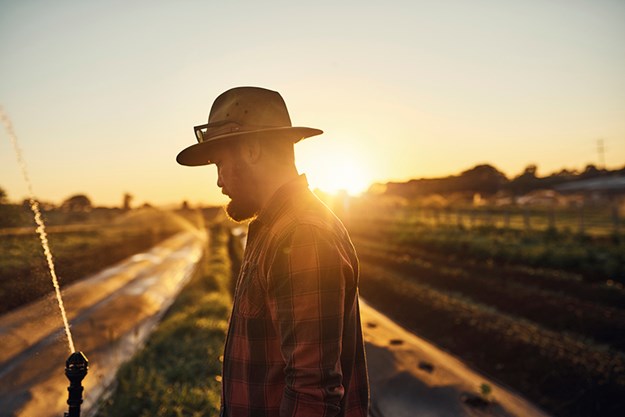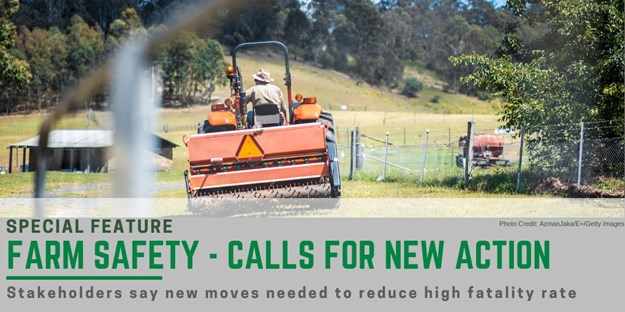With a high number of fatal accidents still taking place on farms, how can tractor safety be improved? Ricky French reports
 |
|
With more than 5,000 visitors a week, safety is paramount to agri-tourism business The Farm
|
When Johno Hunter was growing up on a farm in New South Wales he was driving tractors from nine years of age. It was tough but fun work for a kid, swinging the tractor round the rows of grapevines, spraying the vineyard, and helping out his dad. Sometimes he’d need to jump off the tractor to move the drip irrigation or open gates, and from that young age Hunter was taught the golden rule by his dad: turn the damn tractor off before you jump down.
It wasn’t the only rule he learned. Hunter’s dad didn’t muck around where safety was concerned. You didn’t have a radio or music in the cabin, and you had a good look round to see who was there before you put it into gear. You took it slow. And if you didn’t listen to what dad had to say there’d be hell to pay!
“I was a quick learner,” says Hunter. “I had to be, because of how my dad was. He was pretty tough.”
Hunter now runs an 80-acre mixed-use farm near Byron Bay called The Farm. It’s essentially an agri-tourism operation, producing commercial quantities of eggs, pork, beef and vegetables. There’s an on-site restaurant, bakery, produce store and plant nursery – independent businesses that support The Farm’s paddock-to-plate model and play their part in The Farm’s philosophy of “Grow, Feed, Educate”.
Hunter says part of the aim is to promote farming to young people, to demystify the processes, and show the public where their food comes from and the journey it goes on to get to their plate.
With more than 5,000 visitors a week and a multitude of activities occurring simultaneously on any given day, safety is absolute paramount. A single incident could have catastrophic flow-on effects.
“We firmly believe we have an obligation – because we attract so many people – to merge safety and lifestyle,” says Hunter.
“People in the local area turn to us for engagement; they see what we do. So we want to introduce people to significant issues like tractor safety.”
 |
|
Hunter was taught to have a good look around to see who was there before putting a tractor into gear
|
EDUCATION
With tractor deaths and serious injuries on farms still running alarmingly high in Australia, Hunter’s approach to making sure his farm is as safe as it possibly can be came down to the same approach he takes everywhere: education.
A tractor safety workshop was set-up last year on The Farm in collaboration with Kioti Australia, which supplies its tractors.
Kioti’s territory manager Robert Wruck visited The Farm and ran the workshop. Participants included all four independent farmers who operate on the site, plus other employees and members of the public. Hobby farms are a popular lifestyle choice in the northern NSW hinterland, but with that comes risk, especially around heavy machinery.
“The frustrating thing is anyone can walk into a dealer and buy any powered tractor they want,” says Hunter. “There’s no certification process, and for the driver there’s no ‘L’ or ‘P’ plates or any real safety instruction.”
The workshop covered issues such as checking a tractor’s operational capacity – which sounds routine and boring but is actually one of the most important thing to do, given how many accidents happen when driving tractors outside of their specs – plus safety features such as rollover protection structures (ROPS), seatbelts, how to safely put attachments or a front-end loader on and off, and the importance of turning the tractor off before you jump off, just like Hunter’s dad drummed into him.
“It’s about reducing those risks to start with,” says Hunter. “You can jump on a tractor a thousand times and think you know your operation, but the big thing is to not get complacent.”
 |
|
Relying on “common sense” isn’t enough to guarantee farm safety
|
CULTURAL CHASM
Safe Work Australia’s Exploring the Experience of Family Farmers insights report, released in April this year, revealed an illuminating picture of some of the safety attitudes that permeate through Australian farms. It spoke of “culturally inherited values driving behaviour,” which is to say behaviour learned from parents and passed onto their children. It’s exactly the thing that happened to Hunter, only he was lucky in that his father was strict on safety. Not everyone’s dad is.
A key insight from the study was that farmers think about “planning their work in terms of common sense and aren’t conducting hazard identification processes before starting work.” Many farmers quoted in the study said they relied heavily on common sense to manage safety.
It’s something Victorian Farmers Federation (VFF) farm safety extension officer Richard Versteegen would like to see change.
VFF run something similar to The Farm’s tractor safety workshop – a farm safety walk, where they visit Victorian farms and literally take a walk with the farmer, identifying and addressing risks and hazards they may encounter along the way.
“We get them to talk about things that worry them regarding safety and we try to take a systematic approach. We’ll look at things such as silos, heights, dosing from the ground and of course tractors and machinery,” he says.
Versteegen says it’s important farmers are aware that accidents could happen to them, and to consider the consequences should they do. “Talking with farmers it’s clear some have got this belief that it’s not going to happen to me – older farmers especially. They think their common sense will look after their safety,” he says. “Unfortunately, last year on Victorian farms there were 14 fatalities, and most were older than 55. They were farmers who thought they had common sense.”
Versteegen wants to see farmers plan for safety better, before they start a job. “We need farmers to recognise red flags for safety. It might be you’re fatigued, or you’re working alone. The remedy could be as simple as taking a break and drinking some water,” he says.
The good news, according to Versteegen, is that tractors are a lot safer than they used to be, with the addition of ROPS, seatbelts, and hydraulics replacing power take-off (PTO) guards.
But it’s how you use the equipment that is the important factor:
“The right equipment for the right task, and used with the design specifications of that equipment, is critical for safety. Many incidents occur because of people improvising with the wrong piece of equipment,” he says.
So what does this mean for farmers in practice? It means taking a few minutes to think carefully about the task you’re about to perform with your tractor, or other piece of heavy machinery. What is the load capacity and what gradient will you be working on? If you get a blockage will you remember to shut the tractor down completely so there’s no movement? Will you lower your raised implements before you work on them?
It’s these sort of questions Versteegen wants farmers to ask themselves throughout the day as they go about what they may consider to be mundane activities.
“The message has been the same for a long time. It’s not as though people are inventing new ways of injuring themselves when using this type of equipment,” Versteegen says.
 |
|
The Farm ran a tractor safety workshop last year in collaboration with Kioti Australia
|
BACK ON THE FARM
Back at The Farm, Hunter is preparing to run another tractor safety workshop, to be held towards the end of this year. He’s determined to pursue a pro-active approach to safety and he wants other farmers to do the same.
“It’s about being positive. It’s not a scare tactic; we’re not screaming about how dangerous tractors are, it’s about getting that conversation started, not pushing a dogmatic view about how you should do things,” he explains.
Hunter says he’s the first to admit to sometimes being too proud to ask for help or advice. “The workshop is about raising issues so that tractor safety is at the forefront of people’s minds when they go back to their farm. We make it a comfortable atmosphere,” he notes.
Whether full-scale cultural change around safety issues in farming is required is open to debate, but what’s certainly true is that the industry doesn’t face the same rigorous regulation of similarly dangerous industries such as transport and construction. Farmers are more often than not self-employed, responsible for only a small workforce, if any, and not subject to intense safety scrutiny.
Versteegen says the sector can learn a thing or two from industries that have a more systematic approach to safety.
“We recently ran a farm safety walk where the family who were farming the land mentioned they had recently put on a young fellow who came from the construction industry and was very switched on with safety. He highlighted a whole lot of safety issues for the farm and was very clear about what was safe and what was not,” he says.
With farming making up just 2 per cent of the workforce but 21 per cent of worker fatalities it’s clear that change of some kind is needed in the way the industry manages safety.
Another thing that is clear is that there’s no silver bullet. It also means farmers don’t have to look far outside their own farm gate for the answers. The best ideas are often the simplest.
A workshop, a farm walk – anything to get the conversation happening and the brain engaged. Don’t be too proud to ask for help.
“There shouldn’t be one person dying on tractors,” says Hunter.
“I’m fortunate that I can reiterate the good safety messages my dad gave me, but in a different communication style to his. It’s vital. We only get one crack at this.”
FOOD FOR THOUGHT
Take a few minutes to think carefully about the task you’re about to perform with your tractor, or other piece of heavy machinery
- What is the load capacity and what gradient will you be working on?
- If you get a blockage will you remember to shut the tractor down completely so there’s no movement?
- Will you lower your raised implements before you work on them?


